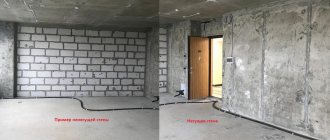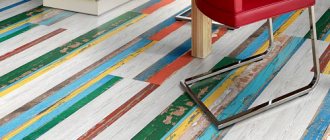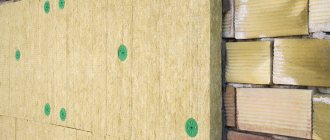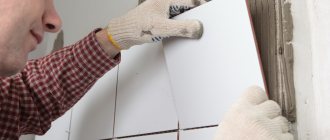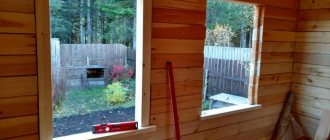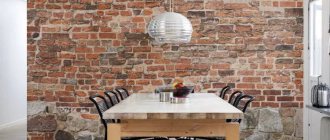Not every wall in an apartment can be dismantled. First make sure that it is not load-bearing, and be sure to check whether permission for redevelopment is required for your project from the housing inspectorate.
Before dismantling a wall made of any material, turn off the power to the apartment, dismantle the wiring and remove the finishing: wallpaper, plaster, drywall that was used to line the wall. Don't forget to protect the floor around and the furniture in the room. And also think about construction waste - it should not be thrown into household waste containers. You will have to call representatives of a specialized company.
What walls can be dismantled?
Load-bearing walls are the fundamental elements of the structure; they serve as supports for the floors, so breaking them is prohibited. You can demolish conventional partitions made of the following materials:
- brick,
- concrete,
- foam block,
- stone,
- tree,
- drywall.
Their thickness usually does not exceed 38 cm.
If the repair affects internal partitions and walls - complete or partial demolition, formation or filling of openings - you first need to make sure that prior approval from the housing inspection is not required. Permission is not required in situations where manipulations affect only non-load-bearing structures.
In this case, the redevelopment will be legalized after the work has been completed. But there are exceptions: listed houses and buildings with wooden floors. In such a situation, before starting work, it is necessary to submit to the residential technical inspection a conclusion on the condition of the structure and the safety of the planned intervention. In relation to load-bearing walls, regulatory authorities can only give permission to construct an opening.
About Khrushchev
Such buildings are built according to the same scheme. They consist of three longitudinal load-bearing walls; they are crossed by transverse ones. There are also walls facing the staircase (also load-bearing).
Therefore, removing the wall between the kitchen and the room in such an apartment will not be difficult. It must be remembered that not all rooms can be combined. For example, you cannot do redevelopment in such a way that, for example, the wet area (bathroom, toilet) moves to a room that is a living room in other apartments in the riser. It is unacceptable.
General rules of the process
If a wall is dismantled unprofessionally, there is a high probability of redistributing the load on the structure, so partial demolition is often carried out: an opening is formed, for example, resting on a column. Also, you cannot knock out the wall along the perimeter in one piece, otherwise the middle will collapse (this could be hundreds of kilograms), and disassembling and removing it will be extremely problematic.
Regular rules of operation using the example of a brick partition:
- the canvas is disassembled in small segments, knocking out brick by brick;
- in the case where there is a doorway in the location to be demolished, first remove the door lintel, gradually expanding the coverage upwards and to the sides;
- the main working tool when dismantling a brick surface is a sledgehammer; the wall is destroyed in the direction from the ceiling down;
- During the process, cracks form in the canvas, due to which the material will fall out on its own.
You can break a brick wall with a sledgehammer.
General techniques for correctly breaking a wall in an apartment:
- It will be easier to break the structure into parts. It is necessary to outline the weight and dimensions of the pieces to be removed in advance. In the case of concrete and brick, it will not be possible to lift more than 10 kg at a time. A concrete partition can be sawed with a grinder using an appropriate disk; it is advisable to first mark it with a marker. Such manipulations do not create much noise, but a lot of dust is generated.
- Walls are often chiselled with a chisel and sledgehammer. It is important to act carefully here so as not to destroy surrounding structures.
- Professionals use a hammer drill and a drill: they divide the area into sections using markings, drill holes and gouge out pieces with a hammer or chisel.
Concrete and brick surfaces are generously sprayed with water to reduce the spread of dust. For the same purpose, the entrance to the room is covered with a wet sheet or piece of fabric.
What can't be destroyed?
Apartment owners are strictly prohibited from demolishing load-bearing walls. The fact is that these structures play a key role in the stability of the entire apartment building, ensuring uniform load distribution.
If permanent partitions are dismantled, there will be a threat of destruction of the entire building, and, consequently, harm to the life and health of other residents.
Thus, property owners should be aware that the dismantling of a load-bearing wall will never be agreed upon. Moreover, the implementation of such changes without permission will necessarily entail the need to restore the destroyed main wall.
Overview of required tools
The choice of tools is determined by the material from which the walls are made. In particular, if it is necessary to demolish a brick partition in the bathroom, it is advisable to prepare:
- pickaxe, crowbar;
- steel wedges;
- chisel;
- sledgehammer;
- jackhammer.
A wooden structure can be disassembled using a chainsaw; for a concrete structure, you will need a hammer drill, an angle grinder, and a jackhammer. More serious instrumentation in the latter case is explained by the presence of metal reinforcement in the concrete slab.
You will need the following protective equipment:
- respirators;
- gloves;
- masks;
- glasses;
- tight closed shoes;
- film for covering furniture, windows, floors.
To break a wall, do not forget to take a respirator, gloves, and a mask.
Depending on the volume and scope of work, a spatula, a nail puller, a construction vacuum cleaner, and a shovel may also be useful.
Preparatory work
When preparing an apartment, first of all, all communications are turned off: heating, water supply, television antenna, gas pipeline, sewerage, electricity (the list depends on the specifics of the premises affected by the redevelopment). You should also take care of packaging for the resulting construction waste - here you will need bags made of durable material.
A major overhaul involves getting rid of switches and sockets, built-in cabinets, screeds, doors and windows. As a result, bare walls and floor slabs should form.
Inside the dismantled surfaces there may be water pipes, fittings, and electrical wires. To find a hidden electrical network, you should use a non-contact probe. If wires become visible during demolition, you need to tap the pieces around them as carefully as possible, in no case allowing heavy pieces of material to sag on them.
Concrete walls in panel houses contain steel reinforcement, and here the fastest and most effective method of dismantling is the use of an angle grinder with a metal disc. The tool allows you to cut metal components efficiently.
If you are planning a bathroom renovation, you need to keep in mind that the plumbing is often hidden in the partition under the tiles. When buying an apartment that has already been finished, there is a high probability that there are pipes in the concrete wall. Therefore, the structure should be disassembled in the least destructive way. To prevent an emergency, you need to turn off the water and carefully dismantle the old communications.
Each region has its own regulations for organizing repairs in apartment buildings: hours are set during which noise is prohibited, and in most cases it is forbidden to disturb the silence on weekends.
Consequences of unauthorized changes
Each apartment owner planning to change the layout of a load-bearing wall should remember the liability that may arise in the absence of official permission to carry out such repair work. We are talking about the following negative consequences:
- payment of a fine in the amount of 2,000 -2,500 rubles;
- difficulties arise when registering legally significant transactions with an apartment where illegal redevelopment has been carried out (for example, the sale of real estate);
- the need to restore the load-bearing wall and bring it back to its original form;
- sale of the offender’s apartment at public auction (if he does not restore everything on time).
Attention. If the redevelopment of a load-bearing wall does not pose a threat to the stability of the entire house, as well as to the life and health of other people, then it can be agreed upon after it has been completed. In this case, the premises can be left in a changed form based on a decision of the judicial authority (clause 4 of article 29 of the Housing Code of the Russian Federation).
Implement options
It is most convenient to use a grinder, a jackhammer, an impact drill or a hammer drill when destroying partitions. The choice of tool is determined by the scope of work and the base material of the wall.
Using an angle grinder
A concrete wall can be cut down with a grinder equipped with an appropriate disk. To make the work easier, you should first mark the wall: as a result, pieces should be formed that are easy to control and move.
When choosing equipment, you need to take into account its power and the radius of the disk: the larger the last parameter, the thicker the wall to be removed can be. The advantages of the method are accuracy and lack of noise, the disadvantage is that a lot of dust is generated. Therefore, this method is not suitable for working in small rooms, for example, when demolishing a partition between a bathroom and a toilet: dust will instantly fill the space, and you will have to wait 15-20 minutes for it to settle, and with a new cut everything will repeat. Having a construction vacuum cleaner will help neutralize this effect, but it is common only among professionals.
Using an angle grinder
Using an impact drill and hammer drill
This is the most convenient way to solve the problem on your own; it consists of drilling through holes close to each other according to pre-applied markings. When the piece is completely processed around the perimeter, it can be knocked out with a chisel and hammer, systematically tapping the material. The method is very noisy and dusty, but from the point of view of one’s own safety it is effective.
Using a jackhammer
A powerful tool allows you to quickly eliminate an unnecessary partition; it makes a lot of noise and requires careful handling. If you hammer without a clear plan, there is a high risk of destruction of surrounding structures.
The most popular types of redevelopment
Article on the topic
Repair and rent: how to make someone else’s home cozy and not regret it
Modern apartments in standard buildings rarely have a large area, and therefore most often the walls in them are demolished rather than erected. “Our clients most often turn small one-room apartments into studio apartments by removing the partition between the room and the kitchen. Also, in small apartments, the corridor is often reduced in favor of living rooms, dressing rooms and storage rooms are allocated, if these are not provided for in the project, by making, for example, niches in the corridor. In addition, a balcony is often attached to a living space or insulated and equipped, creating in fact another room, for example an office or a kind of lounge (recreation area),” said Vladimir Bogdanyuk, head of the Analytical and Consulting Center Est-a-Tet.
According to Maria Litinetskaya, general director, the simplest and most common redevelopment option is combining or separating bathrooms. This applies to all types of apartments. But it is precisely in small-sized apartments that one of the fashionable trends now is the development of European-style layouts. For example, in a two-room apartment the kitchen and living room are combined and a separate bedroom is allocated.
Wall dismantling technology
Drywall and foam blocks are the most common materials for partitions, and their dismantling is not difficult: the texture and density of the structures facilitate their quick disassembly.
From foam block
This is a universal building material that can be used both in the construction of apartment buildings and in the construction of private houses. The blocks are quickly installed and exhibit excellent sound and heat insulation properties. Therefore, it is customary to assemble internal partitions from blocks, which must be dismantled; a little less often they are used in the construction of external walls.
The raw material for foam blocks is cellular concrete; it is light in weight, can be easily sawed and cut, and holes can be drilled in it using an electric or hand drill. You also need to take into account that special glue is used to connect products, and metal reinforcement is laid to enhance strength.
Taking into account the specified characteristics of foam blocks, it is necessary to prepare the following tools for work:
- sledgehammer,
- grinder,
- hammer,
- saw.
First, the top decorative layer (in particular, putty, plaster) is removed, then individual pieces of material are knocked out using a sledgehammer or hammer. In general, dismantling does not create difficulties; a lot of dust does not form during work.
It is prohibited to throw construction waste into standard containers located near houses, so the foam block wall should be broken into small fragments and packed in durable construction bags.
After all manipulations are completed, the waste is taken to a landfill.
From plasterboard
In apartment buildings built at the end of the last century, partitions based on plasterboard are common. This universal material is easy to break; the main thing is to take care of comfortable working conditions.
The preparatory stage boils down to the following activities:
- when destroyed, drywall creates a lot of dirt and dust, so it is important to vacate the premises in advance and carefully pack all furniture that cannot be removed in film;
- in the process of demolishing this type of partition, the floor will not be damaged, but it will have to deal with all the dirt that is generated. To make subsequent cleaning easier, it is advisable to cover it with protective material or thick oilcloth;
- from the wall that is planned to be eliminated, it is necessary to remove not only decorative elements, but also the door frame and electrical wiring.
Demolition of a structure can be carried out in several ways, depending on its type, since the composition may include plaster slabs or a metal frame. Here are 3 convenient dismantling methods:
- If the partition is assembled from sheet cladding, first of all you need to find the screws and carefully remove everything (a magnet will help in the search). Next, remove the casing and begin disassembling the frame. The advantage of this method is the possibility of reusing the lathing and sheets to build a partition in another place. But there is also a drawback: in order to maintain the integrity of the materials, you will have to spend a lot of time and effort.
- The easier impact method is based on the use of a sledgehammer or hammer. In this case, the material is completely destroyed and taken to a landfill.
- If the task is to make a smooth opening in an existing wall, you should use a diamond cutter. This expensive equipment requires certain working skills.
In the latter case, it is important not only to rid the structure of wiring, it is advisable to draw up a plan for the future interior in advance in order to accurately mark and maintain proportions.
